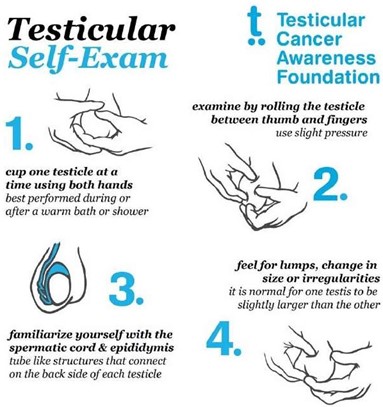A nurse in a provider’s office is reinforcing teaching with a client about performing testicular self-examination.
Which of the following instructions should the nurse include?
“Perform the self-examination every 3 months.”
“Examine your testicles after a warm shower.”
“Palpate both testicles firmly with your fingertips.”
“Apply a cool compress to the scrotum prior to examination.”
The Correct Answer is B
Examine your testicles after a warm shower.

This is because a warm shower will relax the scrotum and the muscles holding the testicles, making an exam easier. You should gently roll the scrotum with your fingers to feel the surface of each testicle and check for any lumps, bumps, swelling, hardness or other changes.
Choice A is wrong because you should perform the self-examination every month, not every 3 months.
This will help you notice any changes over time.
Choice C is wrong because you should not palpate both testicles firmly with your fingertips. You should use a gentle touch and avoid squeezing or pressing too hard.
Choice D is wrong because you should not apply a cool compress to the scrotum prior to examination. This will make the scrotum contract and tighten, making an exam more difficult.
Nursing Test Bank
Naxlex Comprehensive Predictor Exams
Related Questions
Correct Answer is A
Explanation
Offer the client fluids high in fiber and protein every hour. This is because clients who have bipolar disorder and are experiencing mania are at risk of dehydration, malnutrition, and weight loss due to increased activity, poor intake, and impaired judgment. Fluids high in fiber and protein can help prevent constipation and promote satiety.
Choice B is wrong because monitoring the client’s vital signs twice per day is not enough for a client who has mania. The nurse should monitor the client’s vital signs more frequently, at least every 4 hours, to assess for signs of dehydration, infection, or cardiac complications.
Choice C is wrong because encouraging the client to participate in group therapy activities each day can increase the client’s stimulation and agitation. The nurse should provide a calming environment with fewer stimuli and solitary activities for a client who has mania.
Choice D is wrong because weighing the client three times per week is not sufficient for a client who has mania. The nurse should weigh the client daily to monitor for weight loss and fluid imbalance.
Correct Answer is C
Explanation
The HbA1c value determines long-term blood glucose control for the past 120 days. This is because the HbA1c test measures what percentage of hemoglobin proteins in your blood are coated with sugar (glycated). Hemoglobin proteins in red blood cells live for around 120 days, so the test reflects your average blood sugar level for the past two to three months.
Choice A is wrong because an HbA1c value greater than 8% indicates poor diabetic control of blood sugar. The HbA1c target for most people with type 1 diabetes is 48 mmol/mol (or 6.5%) or lower.
Choice B is wrong because the HbA1c value is not altered by eating habits the day before the test. The test does not require fasting and can be done at any time of the day.
Choice D is wrong because an HbA1c test should be performed more than once per year.
The frequency of the test depends on the type of diabetes, your treatment plan and your blood sugar level. For example, you may need the test twice a year if you have good blood sugar control, or four times a year if you take insulin or have trouble keeping your blood sugar level within your target range.
Whether you are a student looking to ace your exams or a practicing nurse seeking to enhance your expertise , our nursing education contents will empower you with the confidence and competence to make a difference in the lives of patients and become a respected leader in the healthcare field.
Visit Naxlex, invest in your future and unlock endless possibilities with our unparalleled nursing education contents today
Report Wrong Answer on the Current Question
Do you disagree with the answer? If yes, what is your expected answer? Explain.
Kindly be descriptive with the issue you are facing.
